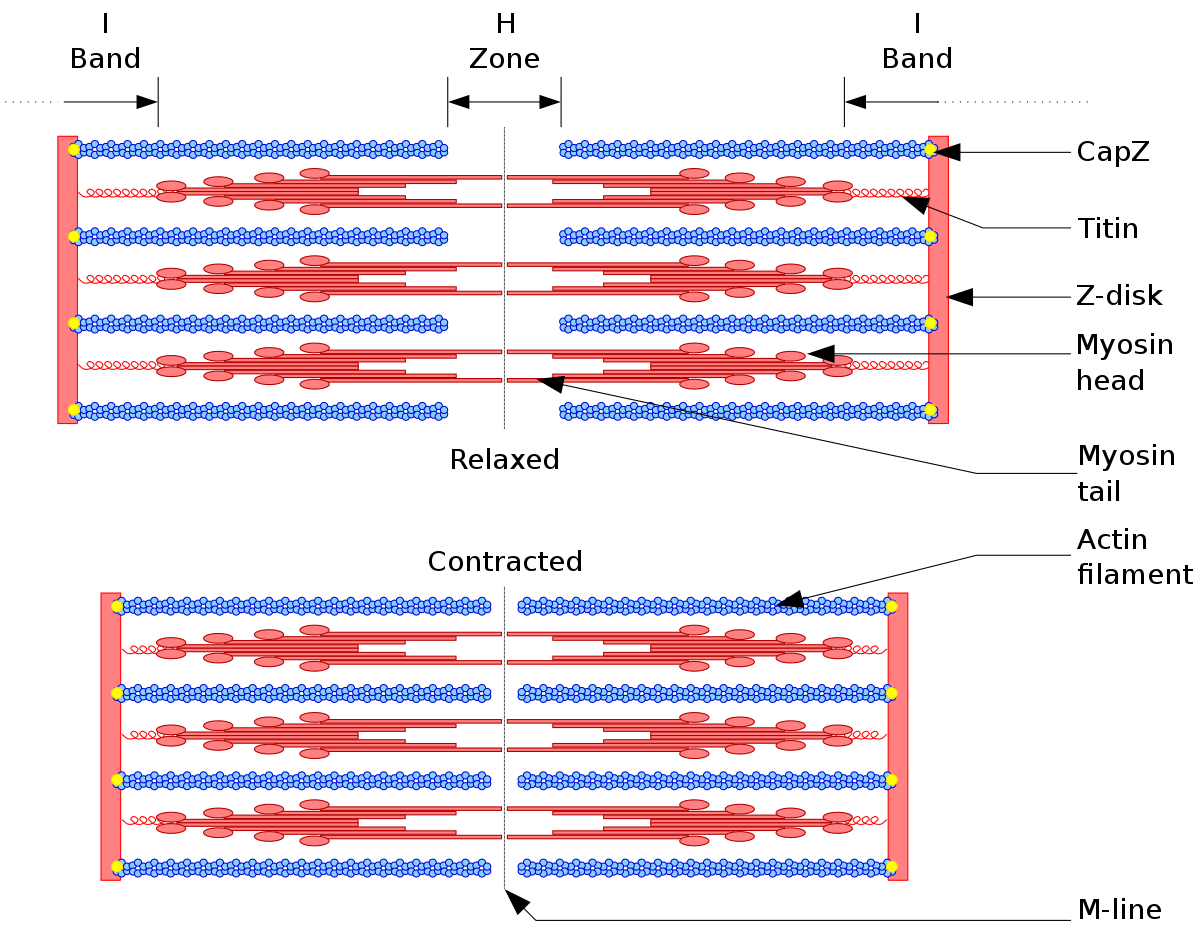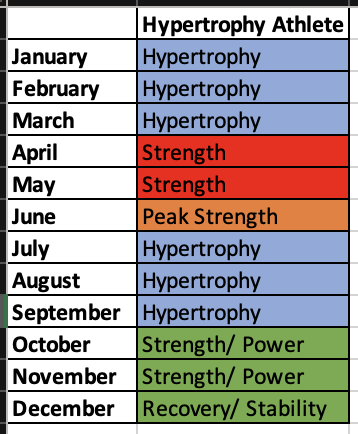CSCS Muscle Hypertrophy | Physiology of Muscle Hypertrophy Explained
Dec 23, 2022
Edited by: Danielle Abel
What is muscle hypertrophy and how does it happen?
Are you studying for the CSCS and wondering how muscle actually gets bigger?
In this article, we're going to break down this process all the way from muscle damage to the recruitment of satellite cells all the way to the repair and growth of muscle fibers to produce muscle hypertrophy. From the most basic level, muscle hypertrophy is associated with resistance training and is simply the process of building new muscle tissue.
We'll use the bicep; for example, if your bicep is smaller than you want right now and you want a bigger bicep, here's how the process will work from a physiology perspective.
If you're a visual learner, this video might help you to understand these concepts too.
Muscle Layers
In order to understand what muscle hypertrophy training is and how it happens, we have to understand how muscles are made up. Muscle physiology is a key concept that you will need to know for the National Strength and Conditioning Association's (NSCA) Certified Strength and Conditioning Specialist (CSCS) Exam.
When we think about the muscle belly, the belly is composed of many muscle fascicles; fascicles are just groups of muscle fibers; fascicles are also known as motor units.
Within each fiber of the fascicle, there are smaller subunits called "myofibrils." Around the fiber (which consists of many different myofibrils) are undifferentiated cells called satellite cells.
Muscle cells have multiple nuclei (the myofibrisl), which are unlike other cells in the body that only have 1 nucleus. When it comes to hypertrophy, having multiple nuclei is a huge benefit because each nuclei can expand in size.
Muscle Damage
Training causes muscular microtrauma to the muscle fibers. Damage occurs from mechanical tension, metabolic stress, and/or muscle damage. (According to Schoenfeld).
- High rep training for more metabolic stress, for example
Metabolic stress results from anaerobic glycolysis energy metabolism for ATP production that causes an accumulation of hydrogen ions, lactate, inorganic phosphate, creatine, and possibly other substrates that promote muscle hypertrophy.
- Heavy load training for mechanical tension, for example
Mechanical tension has been described as a mechanism that includes both force generation and stretching of muscles that promote muscle hypertrophy.
- Eccentric training for muscle damage, for example
Eccentric training is simply focusing more time under tension during the lengthening (eccentric) phase of a movement that also helps to promote muscle hypertrophy.
When damage occurs, portions of the fiber are sheared away, creating small areas of damaged tissue within the myofibrils - areas on the actin and myosin are damaged. This muscle damage eventually produces muscle hypertrophy.
Muscle Protein Synthesis
After microtrauma has occurred, there is a hormonal cascade that initiates the process of muscle protein synthesis. For example, testosterone, IGF-1 (insulin-like growth factor 1), and growth hormone that are going to signal that there's been damage. This signaling will begin activating satellite cells.
Satellite Cells
Satellite cells are DNA-level, undifferentiated cells. So these are cells that could become Type I or Type II muscle fibers. DNA can code or transcribe amino acids, which can be grouped together to form myofibrils or, simply put, more muscle tissue.
When myofibrils are added, sarcomeres are added, which makes the muscle bigger. Making the muscle bigger is the same thing as muscle hypertrophy.
Muscle Fiber Expansion
Just to be even more clear, it's important to differentiate muscle hyperplasia compared to muscle hypertrophy. When more myofibrils (nuclei) are added to the muscle fiber (cell), this process is known as hyperplasia. Still, research is unclear whether this happens in humans as it does in animal studies.
What is more likely is that muscle hypertrophy is occurring, in which the existing myofibrils themselves are repaired with more actin and myosin (sarcomeres) inside of them, which makes the myofibril larger itself by expanding and size of the myofibril.
From a sequential perspective, muscle hypertrophy from satellite cell activation occurs in the following fashion:
- Quiescent (dormant) satellite cell activated by a hormonal cascade
- Satellite cell gets activated and proliferates (replicates)
- Myogenic progenitor forms (myoblasts form)
- Differentiation of myoblasts occurs
- Myocytes are formed following differentiation
- Myocytes fuse together to form myotubes
- Maturation occurs, and the myotubes combined form myofibril tissue inside the myofiber itself
So now you know how muscle hypertrophy actually works, all the way from tissue damage to repair to your muscles becoming larger.
Muscle Hypertrophy Training

Image credit: Wikipedia
Now that you understand how hypertrophy works, you might be wondering how to actually achieve muscle hypertrophy from weightlifting.
According to the research, in order to maximize muscle hypertrophy, we need to be doing the following:
- Maximize metabolic stress
- Cause muscular tension
When we refer to metabolic stress and muscular tension, we're referring to this damage at the level of the sarcomere, the smallest contractile component of a muscle. Pictured above is a sarcomere in its relaxed and contracted state.
The contractile components include actin filaments, myosin tails, and myosin heads. The structural non-contractile components include the z disk, the titan, and the CapZ as represented above.
Additionally, the sarcomere is broken down into geographical areas referred to as bands, zones, and lines, also as depicted above.
When we're thinking about training, we need to recognize that we want to be performing movements that elicit metabolic stress or mechanical tension.
Metabolic Stress
Agonist/antagonist or upper body/lower body supersets
The agonist/antagonist method is an example and could be applied to upper body-only movements where two exercises are paired together. One movement would concentrically work the quads, for example, whereas another movement would concentrically work the hamstrings, for example.
Or it could also be applied to the upper/lower body where two exercises are paired together. Still, one movement works the upper body while the other works the lower body.
This training style is time efficient because it allows one muscle group to work while the other muscle group rests. Since this style of training produces shorter rest periods, the level of metabolic stress would be higher.
Some examples include:
- Quads and hamstrings
- Biceps and triceps
- Pecs and back
Drop sets and cluster sets
Drop sets and cluster sets have also been shown to increase metabolic stress. Drop sets simply refer to the approach where you drop the load on the movement from the highest load. For example, 1 set of 2x15 hack squats at 185lbs followed by 2x10 hack squats at 155lbs. So you're continuing to move the muscle group, but as the load drops, it's likely that range of motion and velocity will also improve while still causing metabolic stress to occur.
Cluster sets simply refer to higher intensity, small sets, and reps with short rest between them. For example, this might look like 6x5 hack squats with 20 seconds of rest between sets. Cluster sets force the body to move the muscle more frequently, which doesn't allow adequate time for metabolites to dissipate, hence causing more metabolic stress.
Mechanical Tension
Mechanical tension is created when you apply force to muscles with weights or other forms of resistance. Some ways you can apply resistance and create mechanical tension include:
- Barbell
- Weight machines
- Weight plates
- Dumbells
- Kettlebells
- Resistance bands
- Medicine balls
- Sandbags
- Suspension equipment
- Ankle and wrist weights
- Bodyweight
Accentuated eccentric training
This method of training uses more load on the lengthening (eccentric) portion of the movement than on the shortening (concentric) portion of the exercise. The reason this is so effective is that the load is applied to the more passive portion of the lift and lengthened phase of the movement, which creates passive mechanical tension by lengthening the extramyofibrillar elements, specifically collagen in the extracellular matrix and in the area of titans within a sarcomere.
Traditionally we thought that contractile components, like actin and myosin, were the main areas that were damaged from training. Still, research shows that other sarcomere components are also affected by mechanical tension and influence muscular hypertrophy, as is the case above with the titan. The titan is not a contractile protein; instead, it is the area where the myosin chains attach to the Z-disk of the sarcomere.
Progressive Overload
Another concept that you'll need to understand well for the National Strength and Conditioning Association (NSCA) Certified Strength and Conditioning Specialist (CSCS) Exam is program design and periodization, including progressive overload.
One key component to continuing to grow muscle includes progressive overload. Progressive overload simply means continuously improving performance over time, which generally includes progressing one of the following variables:
- Increasing time under tension
- Increasing distance
- Increasing range of motion
- Increasing muscular isolation
- Increasing volume
- Increasing intensity (load)
Progressive overload, in general, should be programmed every 2 to 4 weeks, but sometimes there is also a case for weekly overloading as well.
Your body adapts to resistance training; this is why the same sets and reps eventually become effortless. It is important to keep in mind that only about a 10% increase week to week should be applied to prevent overtraining and fatigue which will eventually negatively impact performance.
Don't forget too that all things that go up must also come down. Be sure you are reloading when needed as well. Deloading simply means reducing one of the more of the training variables to improve recovery and allow the body more time to recover.
There is no set time for when to deload, but monitoring training progress through well-documented training logs along with readiness day to day and week to week can help you predict when a deload might be in order.
Periodization and Programming
When it comes to hypertrophy, it's not ideal to train using hypertrophy mechanisms year-round because the body adapts to the same sets and reps over and over. This is where periodization comes in. Progression can be programmed into blocks of training and even annual training plans, with some blocks of training including hypertrophy, and others including endurance, strength, and power. Using the seasonal approach, as described by the National Strength and Conditioning Association (NSCA) Essentials of Strength Training and Conditioning textbook might help:
- Off season
- Pre season
- In season
- Post season

NSCA also refers to these "seasons" as transitions:
- Preparatory
- First transition
- Competition
- Second transition
The idea of periodization is that the structure and logic of the program will change based on the needs of the athlete. For example, a marathon runner who competes in the spring and summer would look much different than a basketball player who competes in the winter and spring.
During the off-season, the runner's program would likely include a hypertrophy sometime in the fall and winter, whereas the basketball player may be training off-season hypertrophy sometime in the summer and fall.
Support & Courses Available
Ready for more support to help you prep for the CSCS exam? Join our Facebook Group, “Strength and Conditioning Study Group,” here. Ready for even more? Our 24-module CSCS Prep Course has muscle physiology completely laid out for you with even more content than what we’ve provided here, plus chapter quizzes to help you pass the NSCA exam; click the link here to check it out.
Stay connected with news and updates!
Join our mailing list to receive the latest news and updates from our team.
Don't worry, your information will not be shared.
We hate SPAM. We will never sell your information, for any reason.

